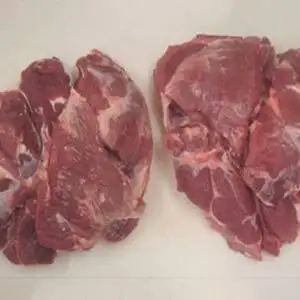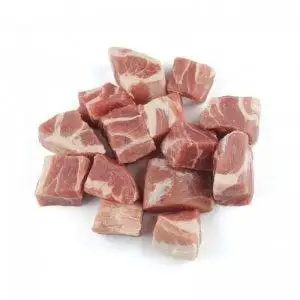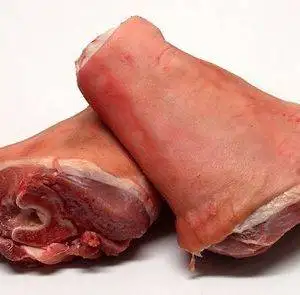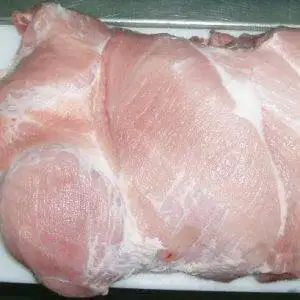Description
Frozen Pork Shoulder Boneless: The Complete Guide
Introduction
When it comes to versatile cuts of pork, few options rival the pork shoulder. Known for its rich marbling, tenderness, and depth of flavor, this cut has been a cornerstone of countless cuisines around the world. In recent years, frozen pork shoulder boneless has gained popularity among home cooks, restaurants, and meal-prep enthusiasts because it offers convenience, affordability, and long-lasting freshness without compromising taste.
Whether you’re planning to make slow-cooked pulled pork, hearty stews, smoked barbecue, or stir-fry dishes, boneless pork shoulder is a cut that delivers exceptional results. Freezing extends its shelf life, making it easier to buy in bulk, store, and use whenever needed. This comprehensive guide explores everything you need to know about frozen boneless pork shoulder—from nutritional value and storage tips to cooking techniques and delicious recipes.
What Is Frozen Pork Shoulder Boneless?
Pork shoulder comes from the upper part of the pig’s front leg. Traditionally, it’s divided into two main parts:
-
Boston Butt (upper shoulder) – Despite the name, this cut doesn’t come from the rear. It is well-marbled, slightly fatty, and excellent for pulled pork.
-
Picnic Shoulder (lower shoulder) – A bit leaner and often used for roasts or braises.
When labeled as boneless, the shoulder has been deboned, leaving behind pure meat that’s easier to slice, cube, or shred. Freezing this cut involves rapidly lowering the temperature after processing, locking in nutrients and preserving freshness until you’re ready to cook.
Nutritional Value of Boneless Pork Shoulder
Frozen pork shoulder retains the same nutritional profile as fresh pork when stored and thawed properly. On average, a 100-gram serving of cooked pork shoulder provides:
-
Calories: ~250
-
Protein: 26g
-
Fat: 17g (with healthy monounsaturated fats)
-
Iron: 1mg
-
Zinc: 2.5mg
-
B vitamins (B1, B3, B6, B12): Essential for energy metabolism
Boneless pork shoulder is high in protein, making it excellent for muscle growth and repair. It also contains valuable micronutrients that support immune function, red blood cell production, and overall vitality.
Tip: Trimming visible fat before cooking can reduce calorie content without sacrificing flavor.
Why Choose Frozen Pork Shoulder Boneless?
1. Convenience
Frozen meat can be stored for months, allowing you to buy in bulk and use as needed. This is especially beneficial for busy households and food businesses.
2. Cost-Effective
Buying boneless pork shoulder frozen often costs less than fresh cuts, especially when purchased in larger quantities.
3. Less Waste
Freezing ensures that the pork shoulder remains usable long after purchase, reducing food waste.
4. Consistency in Quality
With modern freezing technology, the flavor and texture of pork shoulder remain intact, providing a consistent product every time.
5. Versatility in Cooking
Boneless cuts are easier to handle, making them perfect for stir-fries, curries, roasts, tacos, and barbecue dishes.
Frozen vs Fresh Pork Shoulder
| Feature | Frozen Boneless Shoulder | Fresh Boneless Shoulder |
|---|---|---|
| Shelf Life | 6–12 months (frozen at -18°C) | 3–5 days (refrigerated) |
| Convenience | Ready anytime after thawing | Must be cooked within a few days |
| Nutrient Retention | Preserved when flash-frozen | Slight nutrient loss over time |
| Availability | Year-round | Seasonal variations possible |
| Price | Often more affordable | Usually higher |
Both options are excellent, but frozen boneless pork shoulder is often the smarter choice for meal planners, bulk buyers, and those who value convenience.
How to Store Frozen Boneless Pork Shoulder
Proper storage is essential to maintain flavor, texture, and food safety.
-
Freezer Temperature: Keep at or below -18°C (0°F).
-
Packaging: Store in vacuum-sealed bags or airtight freezer-safe containers to prevent freezer burn.
-
Labeling: Mark packages with the date of freezing to keep track of shelf life.
-
Avoid Refreezing: Once thawed, cook immediately instead of refreezing to preserve quality.
Thawing Frozen Pork Shoulder Safely
Thawing meat the right way prevents bacterial growth and maintains tenderness.
-
Refrigerator Method (Recommended): Place the pork in the fridge for 24–48 hours.
-
Cold Water Method: Submerge the sealed pork in cold water, changing water every 30 minutes.
-
Instant Pot/Pressure Cooker: Can be cooked from frozen for certain recipes, though thawing first is ideal.
⚠️ Avoid thawing at room temperature—this creates a breeding ground for harmful bacteria.
Best Cooking Methods for Boneless Pork Shoulder
Boneless pork shoulder is incredibly versatile. Here are some top cooking methods:
1. Slow Cooking
Perfect for pulled pork, stews, and braises. Low heat allows fat and connective tissue to break down, creating tender, juicy meat.
2. Smoking
Ideal for barbecue lovers. A slow smoke at 225–250°F produces melt-in-your-mouth results.
3. Roasting
A classic method. Season generously, roast low and slow, and finish with high heat for a crispy crust.
4. Pressure Cooking
Cuts cooking time dramatically while still delivering tender, flavorful pork.
5. Stir-Frying & Pan-Searing
Boneless cuts can be sliced thinly and used in stir-fries, fajitas, or tacos.
Flavor Pairings & Marinades
Pork shoulder works beautifully with bold flavors. Try these pairings:
-
Classic BBQ: Paprika, garlic powder, brown sugar, cayenne, and apple cider vinegar.
-
Asian-Inspired: Soy sauce, ginger, garlic, sesame oil, and chili paste.
-
Latin Flavors: Cumin, oregano, lime juice, and chili powder.
-
Mediterranean: Olive oil, rosemary, thyme, lemon, and garlic.
Marinating overnight (or at least 4 hours) enhances tenderness and flavor penetration.
Recipes with Frozen Boneless Pork Shoulder
Here are three crowd-pleasing recipes to try:
1. Classic Pulled Pork Sandwiches
-
Slow-cook seasoned pork shoulder with onions, garlic, and BBQ sauce.
-
Shred and serve on toasted buns with coleslaw.
2. Pork Shoulder Carnitas
-
Braise pork with orange juice, cumin, garlic, and chili powder.
-
Crisp the shredded meat in a skillet before serving in tacos.
3. Asian Pork Shoulder Stir-Fry
-
Slice thawed pork thinly.
-
Stir-fry with soy sauce, ginger, broccoli, and bell peppers.
-
Serve over steamed rice or noodles.
Buying Guide: How to Choose Quality Frozen Pork Shoulder
When shopping for frozen boneless pork shoulder, look for:
-
Color: Meat should appear pinkish-red, not gray or pale.
-
Fat Distribution: Even marbling ensures tenderness and juiciness.
-
Packaging: Vacuum-sealed or airtight packaging prevents freezer burn.
-
Origin: Choose pork from reputable farms with traceable sources.
-
Certifications: Look for USDA, EU, or local food safety approvals.
Frequently Asked Questions
1. How long can frozen boneless pork shoulder last in the freezer?
Up to 12 months at -18°C, but best quality is within 6 months.
2. Can you cook pork shoulder from frozen?
Yes, but slow cooking or roasting from frozen takes longer. Thawing first gives better results.
3. Is boneless pork shoulder leaner than bone-in?
Yes, boneless cuts tend to be slightly leaner, though still rich in marbling.
4. Can I use frozen pork shoulder for smoking?
Yes, but it should be fully thawed before smoking for even cooking.
5. What dishes are best made with pork shoulder?
Pulled pork, stews, curries, stir-fries, carnitas, and barbecue are all excellent.
Conclusion
Frozen pork shoulder boneless is a kitchen essential for anyone who loves flavorful, versatile, and affordable cuts of meat. It offers the perfect balance between convenience and quality, making it a smart choice for home cooks, caterers, and restaurants alike. From slow-cooked pulled pork to spicy stir-fries and hearty roasts, this cut adapts beautifully to different cuisines and cooking styles.
Whether you’re planning to make slow-cooked pulled pork, hearty stews, smoked barbecue, or stir-fry dishes, boneless pork shoulder is a cut that delivers exceptional results. Freezing extends its shelf life, making it easier to buy in bulk, store, and use whenever needed. This comprehensive guide explores everything you need to know about frozen boneless pork shoulder—from nutritional value and storage tips to cooking techniques and delicious recipes.






Reviews
There are no reviews yet.